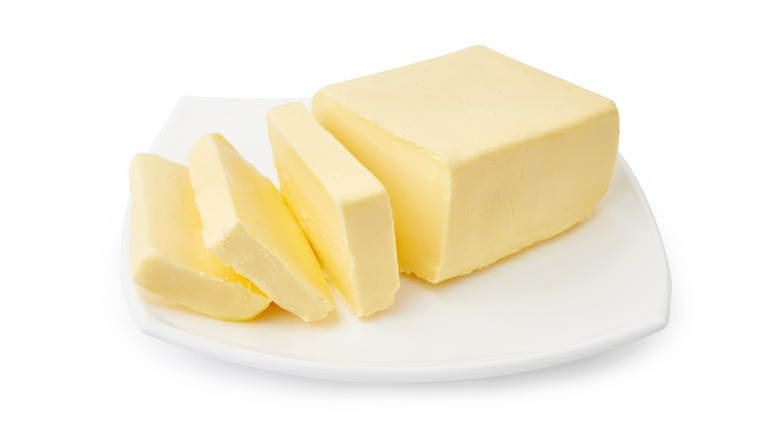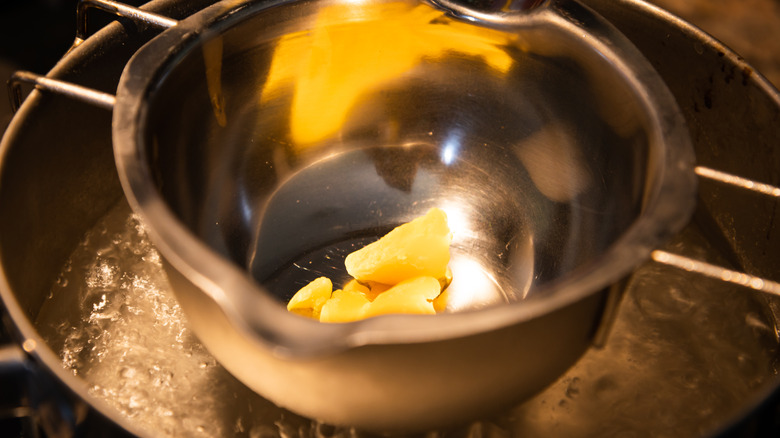To Soften A Stick Of Butter Quick, Give It A Bath
A basic cookie recipe generally calls for butter, let's say half a stick or so. But when you're baking cookies and ready for the butter, you realize that it's been sitting in the fridge and will take a little bit of softening up. You can try putting it in the microwave, sure, but it's always hard to find that perfect moment between the butter still being too hard or outright melting.
Whether you're making dessert or buttering up toast, a pat of hard, cold butter, be it unsalted, salted, or even truffle butter, always seems to be there just when you need your butter to be soft and spreadable. While a minor annoyance, softening your butter without melting it is very simple to do. Southern Living suggests cutting or grating the butter into cubes to help it soften up faster, or you can take a suggestion from MasterClass and mix the butter by itself until the butter begins to form a smooth, cohesive mass. You can also just let it sit out at room temperature, which is an effective but lengthy method.
But what's this about giving your butter a "bath?" Does this method imply that you soak your stick of hard butter in a bowl of water until it gets soft? This is technically correct, although this process of bathing your butter is similar to the "double-boiler" method of making chocolate.
Use boiling water to help soften your butter
Perhaps you've melted chocolate via the double-boiler method, which is two saucepans stacked on top of each other, with the bottom one full of water and the top with chocolate. As the water in the bottom saucepan heats up, the resulting steam helps to soften or melt the chocolate in the upper saucepan. This use of bathing your butter follows this same idea.
Simply fill one saucepan with boiling water and then place another saucepan over it. Place the stick of butter you want to be softened into the upper saucepan and stir it to ensure that all sides are exposed to the heat. It's important to remember that you're only trying to soften the butter rather than melt it, so you should keep an eye on it to keep it.
If you don't want to find yourself cleaning out a saucepan full of butter residue, a similar method is detailed by Epicurious. Place your butter in a plastic bag and put it into lukewarm or tepid water, slowly increasing the temperature of the water to allow the butter inside to soften. Again, you should still pay close attention to the butter, or else you'll just have a wet plastic bag full of melted butter.
You can also use a rolling pin or a hot drinking glass
While using boiling water to soften butter is much quicker than just letting the butter sit out, let's say you don't have time to wait for water to boil. You can use another method that doesn't involve boiling water or saucepans — just plastic wrap or parchment paper, a rolling pin, and a pretty good arm.
As Insider explains, "pounding" the butter is exactly what it sounds like. Cover your stick of butter with either plastic wrap or parchment paper and, using your rolling pin, smash the butter until it's flat. While it doesn't change the temperature of the butter the way the water bath does, this helps to soften the butter to a much more workable form. Bonus — it's also a great stress reliever.
Another quick tip that can help soften butter without melting it too much is a trick demonstrated by Natasha's Kitchen (via YouTube). Fill a tall glass with hot water and then dump the water out. Place your stick of butter on a paper towel or plate standing vertically before covering the butter with the glass. The low residual heat from the glass will help to soften the butter without running the risk of melting it. Let the butter remain under the glass for five to seven minutes or until the butter is softened to your liking.

